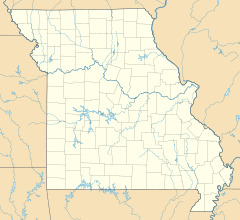Leeper, Missouri facts for kids
Quick facts for kids
Leeper
|
|
|---|---|
| Country | United States |
| State | Missouri |
| County | Wayne |
| Elevation | 489 ft (149 m) |
| Time zone | UTC−6 (Central (CST)) |
| • Summer (DST) | UTC−5 (CDT) |
| GNIS feature ID | 750680 |
Leeper is a small, unincorporated community in southwestern Wayne County, Missouri, United States. It is located right by the Black River. You can find it about five miles south of Piedmont, where Routes 34 and 49 meet.
History of Leeper
Leeper got its name from a Union Captain named W.T. Leeper. In 1871, Captain Leeper helped convince the Iron Mountain Railroad to build its tracks through his land. This was a big deal, even though the railroad had to cut through two mountains to do it!
In 1872, the Clarkson Sawmill moved to Leeper and started operating. This quickly made Leeper a "boom-town," meaning it grew very fast. Leeper was officially founded in 1874 by W.T. Leeper's son, Sid. By 1881, Leeper was a real town with its own post office, which was called Leeper Station back then. The town had one hotel and four stores. The Ozark Hotel in Leeper was even considered one of the fanciest resorts in Wayne County in the early 1900s.
Famous People Connected to Leeper
One of Leeper's well-known residents was Jessie Beard Rickly. She was born in Leeper in 1895. When she was a teenager, she convinced her parents to let her move to St. Louis to study art. Her beautiful artwork is still shown today, and its value continues to grow.
Another famous person linked to Leeper, though not from there, is George Sisler. He was a baseball player known as "Gorgeous George." Sisler played for the St. Louis Browns. He held the Major League Baseball record for the most single hits in a season from 1920 to 2004.
One year, Sisler visited Leeper to see his friend Herman Radke. They went quail hunting together. It was common for Radke to drive hunters down the railroad tracks in his Ford truck. One evening, while waiting for a train to pass, Radke, Dr. Owens, Sisler, and Paul Simmons were all waiting in the station. Dr. Owens found a deck of playing cards, and the men started playing a small game of poker.
A short time into their game, three masked men suddenly entered. Two of them had weapons. The masked men began to rob the poker players, taking their money, jewelry, and anything valuable. Paul Simmons asked them to let him keep his wedding ring, and they agreed. Sisler, on the other hand, cleverly turned his ring around to hide it.
Since Leeper was a small town, Dr. Owens recognized one of the coats worn by the masked men. After the robbers left, Dr. Owens told the authorities, and the three men were caught. However, during the court trial, which Sisler had to travel back for twice, the judge decided something surprising. Because the men had been gambling, even for small amounts, the robbers were found innocent and set free.
W.T. Leeper's Contributions
William Thomas Leeper was born in Kentucky. He moved to Wayne County in 1857. He bought a large piece of land, about 225 acres, in what is now Mill Spring and Leeper.
Leeper is remembered for his important role in bringing the railroad to the area. He helped convince the Iron Mountain Railroad to build tracks through Leeper, which was a big step for the town's growth.
After his time in the Union Army during the Civil War, Leeper continued to be involved in his community. He served as a member of the 25th Assembly of Missouri. He also worked on the Committee for Education and helped expand rural schools in Wayne County. These efforts helped improve learning opportunities for children in the area.
W.T. Leeper passed away on May 19, 1912, and is buried in Wayne County.


